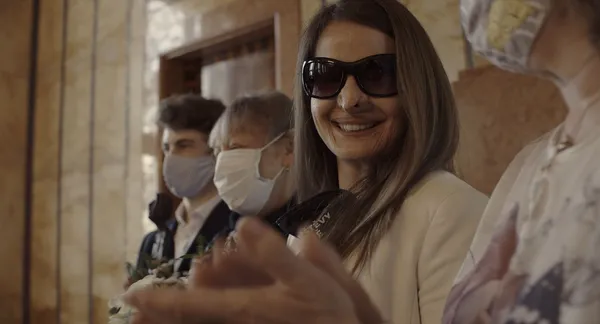Eye For Film >> Movies >> Is There Any Place For Me, Please? (2023) Film Review
Is There Any Place For Me, Please?
Reviewed by: Jennie Kermode

Screening at the Glasgow Film Festival just a few weeks after the brutal attack on a woman and children in London, Jarmila Stukova’s documentary about the victim of an acid attack might sound like grim viewing. It presents a catalogue of horrors, some of which might never have crossed your mind before, and yet it’s also a story of survival, adjustment and reclaiming a place in the world, full of unexpected joys.
The story of the attack that changed Martina Izingová’s life is a familiar one. She had been with her boyfriend for two years, loved him, imagined a future with him. It didn’t work out, he took the break-up badly. She started seeing someone else. He started leaving her threatening messages. 80% of acid attack victims are women and their assailants are usually men they know. “I remember it like it was yesterday,” Martina says: the suddenness of it, the pain so severe that it made her black out, the sensation of her sight fading as she got into the ambulance. Having swallowed and inhaled the acid too, she wasn’t expected to live. When she did, she found herself with a whole new set of problems, and realised that she had lost most of the things she had really valued about being alive.

When we meet her, some months later, she’s still having weekly or bi-weekly check-ups, each one of which is a grim reminder of what happened. Ongoing work is needed to ensure that the skin grafts will stay in place. We see her sitting on her bed in the dark, putting on a plastic mask and gloves, a shot which will recur towards the end of the film in a different form. Although we see her managing a little distance with a cane, despite the complicating presence of autumn leaves, she’s afraid to leave her home alone, fearful that people will perceive her as a monster. She’s single and unemployed and has little hope that that will change.
Many people go through a phase like this immediately after becoming disfigured or disabled. Because she has needed so much help to survive, that’s all that anyone around her has focused on, denying her the mental space to get away from the acute awareness of what she’s lost. There’s a principle in medicine which involves always being honest with patients about the worst case scenario, but sometimes, when suffering from the kind of anxiety an attack like that can cause, assume that means that everything will go as badly as it possibly can. Overcoming this is the first step on Martina’s journey, and Stukova has intimate access to her thought processes as she makes her way through it.
The excellent medical care that Martina has received is not matched by a similar level of help with reintegration. Gradually we see her discovering new tools which empower her to reclaim areas of her life. Many disabled people are wary of the sort of film that presents saviour narratives and puts a focus on learning to imitate a conventional life rather than reckoning with life on its own terms. Stukova keeps it grounded, however, acknowledging that technology – at least in its present state – can’t fix everything, and showing us Martina’s disappointments as well as her triumphs. We also see her grow as a person, acknowledging her own past prejudice towards anyone who wasn’t beautiful, learning to think through all sorts of matters more deeply and developing real empathy.
The last big hurdle is love. Not finding a lover – once she recovers a bit of confidence, she soon discovers that there are men out there who don’t have a problem with the way she looks. This is complicated by the recognition that some of them might hurt her, and that she has always tended to be attracted a dangerous men, a truth she can no longer hide from herself. The difficult part is making room to accept that somebody could love her, and that it could be worth his while to do so.
Underlying the film is an awareness of the social pressure on women to conform to a certain beauty standard, and to deprecate the attractive features they have. Unable to see herself, Martina no doubt imagines the worst. Viewers will, from the start, notice her strong cheekbones and dazzling smile. Despite ongoing reconstructive work, the damage alongside this will never fully go away, but over the course of watching the film, you may well find that your instinctive perception of what is normal expands, that you cease to notice it. By the end, it’s hard not to see her as beautiful.
Martina’s participation in the film seems to have been inspired by her desire to help other survivors of such attacks and show them that a positive future is possible. This the film certainly does. Beyond that, however, it’s a story about a woman blossoming as she discovers her own potential and learns to articulate herself in the world. This gives Martina a whole additional layer of beauty which most people never achieve. It’s not her mere survival that’s inspiring – another trope which disabled people tend to get sick of – but how far she goes to reach past that and live life on her own terms. She’s an extraordinary person, and Stukova’s documentary, which screened as part of the 2024 Glasgow Film Festival, shows us the work that made that possible.
Reviewed on: 03 Mar 2024















